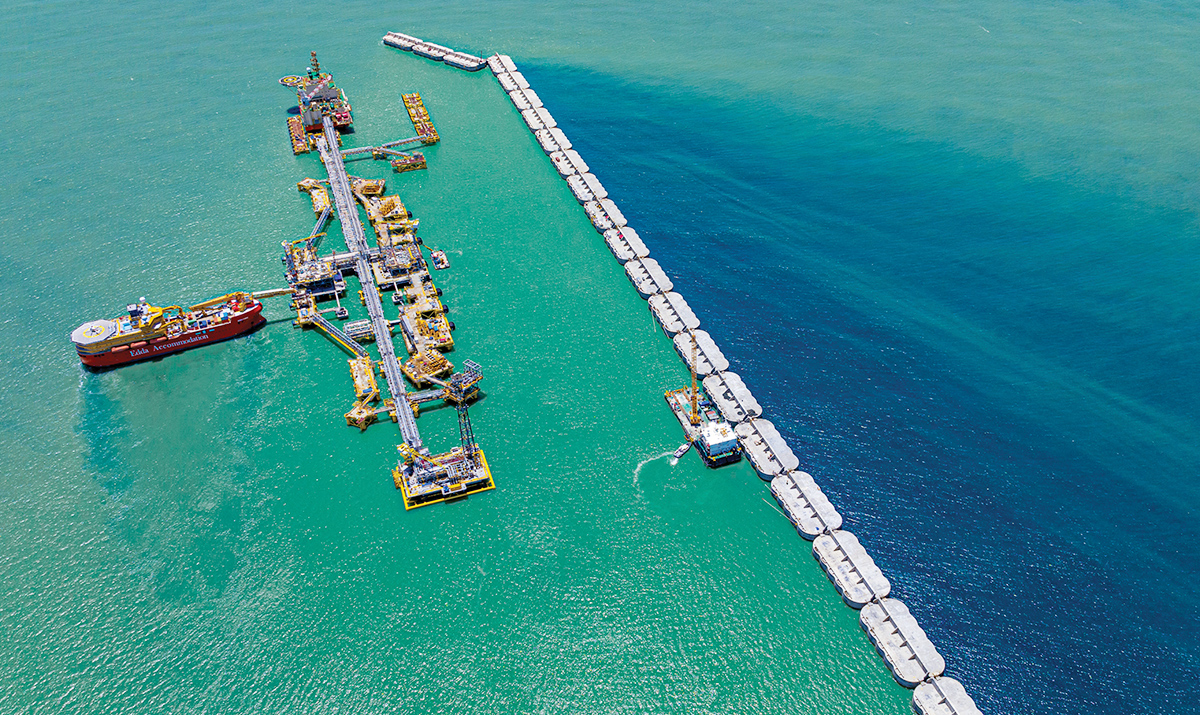
27 Nov Africa’s newest energy hub
Mauritania’s economy is transitioning as it starts to exploit its rich potential in natural gas, renewable energies and green minerals
According to Minister of the Economy and Sustainable Development Abdessalam Ould Mohamed Saleh, the Mauritanian economy has “caught a wave that translates into strong growth of 6.4% for 2022, around 4.8% in 2023 and above 5% for the years to 2026.” The country’s robust performance has been led by mining exports to date — with the most important contributors being gold, thanks to a recent doubling of production at the Tasiast facility run by Canada’s Kinross that has made it one of the ten-largest gold mines in Africa, and iron ore, with Mauritania being the continent’s second-largest producer of that mineral.
The nation’s medium- and long-term positioning is also looking good, adds Saleh: “Mauritania’s economy is in a transitional phase, because of reforms we have conducted, large-scale infrastructure projects and the potential of our extractives industries, including new mining and gas projects, which will start producing effects in 2024 and fully kick in by 2028.”
At present, projects are underway or in advanced stages of discussion with investors that could generate 24 million extra tons of iron ore — about double the amount the country extracts today. Promising prospective work is taking place in the largely unexplored country for minerals like gold, iron, uranium and rare-earth elements as well.
And next year the nation will begin to exploit its estimated 110 trillion cubic feet of untapped offshore natural gas reserves, when the Greater Tortue Ahmeyim field that is jointly owned by Mauritania and neighboring Senegal goes online. “The field is operated by BP and Kosmos Energy and discussions are also ongoing with both companies for the development of our large BirAllah gas field. Mauritania offers good prospects in gas and we could become a significant hydrocarbon player by the end of the decade,” reveals Saleh.
Mauritania’s future will not solely be based on extractive industries, asserts Minister of Foreign Affairs, Cooperation and Mauritanians Abroad Mohamed Salem Ould Merzoug: “Thanks to the vision of President Mohamed Cheikh El Ghazouani, our country has resolutely chosen to build a new base of growth and prosperity that is articulated around our renewable natural resources in agriculture, livestock, fishing and energy.” As he is keen to stress, “That in no way excludes the valorization of our finite natural resources. This combination will allow us to depend less on extractive industries by diversifying our economy and will lay the foundations for lasting strength in Mauritania’s development.”
Diversification to date has faced a number of constraints, not the least of which is a ready supply of energy. “We continue to work to improve the performance of our fisheries and agricultural sectors, which is largely dependent on the local transformation and valorization of products. That requires the availability and affordability of critical inputs like energy,” says Saleh. “We expect the big transformation in these sectors to happen around 2028, once we have a lower-cost and reliable source of locally produced energy in our mix.”
This energy will come not just from the country’s gas but from renewable sources. According to the International Renewable Energy Agency, Mauritania has more than 4,000 gigawatts of potential in green energy. The northwest of the country in particular offers a unique environment for wind and solar that could be combined to make energy available 24 hours a day all year long. “We have an ambitious vision for developing our formidable wind and solar resources for domestic use and for green hydrogen. Numerous studies have confirmed that Mauritania could be one of the best places in the world for green hydrogen production,” Saleh states.
The government’s strategy involves generating enough of the green fuel for exports plus local uses, such as manufacturing green steel, he adds: “Green hydrogen would accelerate the country’s industrialization and transformation. If Mauritania developed its green energy potential, it would record an economic growth rate of 10% and more over two decades, while saving the world the equivalent greenhouse gas emissions of a medium-sized industrialized country.”
The government is aiming to harness this potential in collaboration with international public and private sector partners. In October, it took a major step toward that when President Ghazouani and European Commission President Ursula Von der Leyen launched the Team Europe Initiative for developing Mauritania’s green hydrogen industry in Brussels. At the event, Von der Leyen stated: “The European Union fully shares [Mauritania’s] ambition to develop as a hub for green hydrogen.” The initiative will be backed by substantial investments from an economic bloc that is desperate to diversify and decarbonize its energy supply chains.
“This is our future and that is why I say we are in a transitional economic phase. We will probably reach our real economic growth potential at the end of this decade,” says Saleh. “In the meantime, Mauritania is open for business and we welcome foreign direct investment. This is a place where you can find a unique mix of mines, renewable energy and gas, which has the opportunity to be a hub for producing and exporting low-carbon energy and green minerals.”
